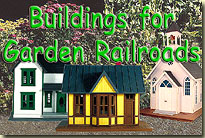


|
Garden Railroad Structures
Trains need people and businesses to serve. Industries give your railroad a raison d'etre, while they add a sense of realism and points of interest. Houses and stores symbolize the communities that the railroad serves.
As the hobby of Garden Railroading has matured, we've recognized the many differences between structures built for indoor railroads and structures built to look good and to last in harsh weather conditions. (We've also recognized the economic differences, which is one reason trashbashing caught on early and continues to be practiced.)
 Deprived of cardboard, brick paper, and many kinds of paint and craft products, learning to use weather-resistant materials such as PVC, concrete, and aluminum, or to protect other materials, such as wood and plastic, against the weather, many garden railroaders have "pushed the envelope" for model structures, in terms of size, realism, and durability. As the rest of us stumble in their wake, we occasionally pick up tips that we can apply. That's where Family Garden Trains comes in. Our hope is to provide articles that summarize what we have learned so far in ways that any new hobbiest can understand and apply. Eventually we hope to add other articles that provide details and alternative methods that may appeal to the more experienced modeler. Deprived of cardboard, brick paper, and many kinds of paint and craft products, learning to use weather-resistant materials such as PVC, concrete, and aluminum, or to protect other materials, such as wood and plastic, against the weather, many garden railroaders have "pushed the envelope" for model structures, in terms of size, realism, and durability. As the rest of us stumble in their wake, we occasionally pick up tips that we can apply. That's where Family Garden Trains comes in. Our hope is to provide articles that summarize what we have learned so far in ways that any new hobbiest can understand and apply. Eventually we hope to add other articles that provide details and alternative methods that may appeal to the more experienced modeler.
Our primary goal is to help you populate your garden railroad with structures that you can prepare with reasonable (but not exceptional) skill and effort, for prices that won't dwarf your investment in the rest of your railroad. At no point will we claim that our way is the only way, or even necessarily the best way. Rather, we describe approaches that have worked for us and will probably work for you.
The articles currently available in the Structures category include:
- Stuff to Have on Hand - A list of products you should keep in your shop so you don't have to run to the store for a couple dollars' worth of glue or primer every time you want to work on a structure.
- Preparing Plastic Garden Railroading Structures for Long-Term Use
In addition, if you want to get some buildings onto your railroad now, with very little fuss (and not too much expense), check out the Buildings for Garden Railroad catalog page.
Buildings for Indoors
Of course any building that will hold up outdoors will also hold up indoors - if you have room for it. Here are some ideas that will only work indoors, but are perfect for storage tracks, train shows, - wherever rain and UV are not an issue. Most of them also keep down space, expense and weight. Also, they're mostly from our BigIndoorTrains(tm) pages.
 Easy Street Scene - This popular building project uses downloadable building graphics and a little cardboard or foam board to build up a convincing downtown scene that is only a few inches deep - perfect for shelf layouts, tight spots, and dioramas. We also provide links to high-resolution graphics that will work for any scale. - April, 2008 Easy Street Scene - This popular building project uses downloadable building graphics and a little cardboard or foam board to build up a convincing downtown scene that is only a few inches deep - perfect for shelf layouts, tight spots, and dioramas. We also provide links to high-resolution graphics that will work for any scale. - April, 2008
 Photo-Based 3-D Buildings - Bob Anderson used our building front graphics to create an entire Large Scale downtown setting for a local train show. It was so well received, he's already thinking about how he can make it better for next year. If you have an indoor railroad of any kind, or if you've been asked to loan buildings to a train show or other display, and you don't have any to spare, this could give you some inspiration.
- New, December, 2010!
Photo-Based 3-D Buildings - Bob Anderson used our building front graphics to create an entire Large Scale downtown setting for a local train show. It was so well received, he's already thinking about how he can make it better for next year. If you have an indoor railroad of any kind, or if you've been asked to loan buildings to a train show or other display, and you don't have any to spare, this could give you some inspiration.
- New, December, 2010!
 Log Cabin Building Flat - This "building flat" uses downloadable graphics and foam board or cardboard to dress up a narrow corner of your railroad or village. The techniques in this project can be used for almost any kind of building you want to represent in a tiny space. December, 2007. Log Cabin Building Flat - This "building flat" uses downloadable graphics and foam board or cardboard to dress up a narrow corner of your railroad or village. The techniques in this project can be used for almost any kind of building you want to represent in a tiny space. December, 2007.
- Related Resources - In addition, we have many photographic and graphic resources you can use to add structures or building fronts to your indoor railroad, including:
Related Articles from Other People
Most of the articles below are for people of "intermediate" skills. However reading them before you start your next big project may help you find a way of doing things that works for you.
- George Schreyer's structure articles - George likes to try out new things, then tell us what he did wrong as well as what he did right. Among his experiments are buildings made of concrete and other inexpensive materials. His pages have a number of articles on these structures and methods. I'm putting a list of the ones I find most interesting here, but once you get to his site, you're bound to find more. If you wind up talking to George, tell him I said, "Hi."
- Making Your Own Windows, by Bruce Chandler - Using styrene strips and a simple form to build attractive windowframes from scratch. Hosted by Large Scale Central web site.
- Building a Stone Mill by Bruce Chandler - Using materials from Stoneworks model builders' supplies, scratchbuilder Bruce Chandler builds an impressive stone-and-concrete mill for his outdoor railroad. Also hosted by Large Scale Central web site.
- Build a Backwoods Water Tank by Dwight Ennis. Redwood "timber" construction makes this project eye-catching. Dimensions are given for 1:20.3 scale, the same scale as the Bachmann Shay. Several parts that you might have to buy from hobby providers are recommended, and navigating the articles is a little tricky, but if you're interested in something truly original and "backwoodsey", take a look. This article also has many tips on scratchbuilding with wood in general, so it's worth a read even if you don't build this particular project. Free, downloadable plans are included.
Note: MyLargeScale.com is planning on moving these articles to a new area, so if this link breaks, please notify me, then go to MyLargeScale.com and navigate to the new articles section. Thanks, Shad, and Dwight for making this resource available.
Tell me about your projects
Our club, the Miami Valley Garden Railway Society, has several individuals whose structure-building efforts far exceed my own, so I know other folks have also pioneered new techniques. Do you have any new technique or recommendation you'd like to add to our list? If you do, especially if you can come up with how-to descriptions and photos, I'd love to post them here.
|



































